Japanese R&D: Branching Out
Applied Clinical Trials
Long overlooked as global drug innovators, Japanese pharmaceutical companies are gaining attention for their novel clinical development programs.
The international pharmaceutical industry is considered to be highly successful, having launched nearly 1,400 new molecular entities (NMEs-compounds that have not previously been made available as human therapeutics) over the last 30 years.1 At present, U.S. and European pharmaceutical companies are seen as the leaders in terms of new drug development. But Japanese companies have also made a steady contribution to global drug output, with their peak of success occurring between 1992 and 19951 (Figure 1).
Rising costs, but declining output
One of the major indicators of the international pharmaceutical industry is the number of new drugs reaching the global market. If companies are to remain profitable and wish to justify to patients and governments the high prices that they charge for their medicines, they must demonstrate that their considerable R&D investment results in new medicines. In 2000, the pharmaceutical industry was estimated to have spent $58 billion on R&D, with around 40% of this devoted to clinical trials.
1
In recent times, there has been concern that the productivity of the major companies has been decreasing. Many of the major companies in the industry have received criticism that they lack new ideas and methodologies. They assert that the industry is producing too many similar new drugs that offer little clinical advantage over those already on the global market.
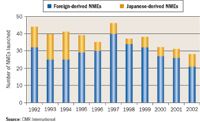
Figure 1. Number of NMEs launched globally (1992-2002).
Even some within the industry itself have expressed concern over current productivity rates, speaking of an "innovation deficit" in pharmaceutical R&D.2 They have questioned whether companies are relying too heavily on line extensions and new drug delivery systems and formulations, rather than on developing novel compounds. One study carried out in 2000 found that major companies were spending a third of their R&D expenditure on line extensions.3
Although global pharmaceutical R&D expenditure increased by 121% between 1990 and 2000, the number of innovative new drugs reaching the marketplace has steadily declined.1 In 2002, the lowest number of novel medicines launched into the world market in over 20 years4 (Figure 1). Twenty-eight NMEs were first launched in 2002, a number that is almost half of the corresponding figure for 1997.4 In 2001, the corresponding figure had been only 31 NMEs.5 The situation was not predicted to improve through 2003, as the decrease in new medicine launches was accompanied by a decrease in new medicine applications within the major regions. During 2002, the FDA, EMEA, and MHLW all reported a fall in submissions.4
Worrisome for the industry, as the cost of clinical development has increased there has been little sign of improvement in drug attrition rates. In a survey of major pharmaceutical companies, CMR International found that mean clinical evaluation expenditure increased from 32.5% in 1996 to 39.5% in 1998.1 In its 2002 survey of U.S.-based companies, PhRMA noted that the inflation-adjusted increases in clinical R&D costs were more than five times greater than the costs for preclinical work.6 Yet despite the efforts made by companies to improve success rates, it is estimated that only 15% of new drugs entering development will subsequently reach the market.7 Even at the latter stages of clinical development, failure rates are less than ideal. Success rates from Phase III to market can range between 50% and 70%.7
To some extent, a clinical R&D expenditure increase is to be expected. Many of the new drugs in clinical development are focused on newer and more difficult disease targets, which will lengthen the overall R&D process due to complex trials. For example, a number of new treatments are being developed for CNS disorders such as Alzheimer's and Parkinson's diseases, where there is a lack of effective treatments.
An analysis of the development times of 574 new drugs that first reached any one of a defined 20-country market between 1984 and 1999 showed that new chemical entities for CNS disorders had the longest overall development times, with a mean of between 12 and 14 years.1 The difficulties in developing new chemical entities for CNS disorders were highlighted by comparisons with other therapeutic classes. In the same analysis, development times for cancer drugs ranged from 10.5 to near 12 years, where those for anti-infectives ranged from 9.6 to 11.7 years.1
Japanese R&D investment
Given the heavy R&D investment and global presence required for success, many observers have overlooked the Japanese pharmaceutical industry as a source of innovation. One of the reasons for this is that Japanese pharmaceutical companies have a relatively low spend on R&D compared with western companies. This has also led to a view that Japanese companies have previously concentrated too heavily on "me-too" products.
8
It is estimated that the average R&D budget of the top 10 Japanese pharmaceutical companies are about 20% of the average for the top 10 western companies.
9
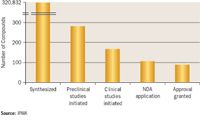
Figure 2. Success rates in developing NMEs for 17 Japanese companies (1992-1996).
In its survey of 17 local companies, the Japan Pharmaceutical Manufacturers Association (JPMA) found that between 1992 and 1996 for each NME submitted for approval to a regulatory authority, 1.6 had entered clinical studies; and for each NME marketed, 1.9 had entered clinical studies.1, 10 This 53% dropout rate in clinical development represented the most substantial loss in R&D investment for Japanese companies.1, 10 However, in spite of such risks (Figure 2), Japanese companies have shown a strong commitment to clinical research. In its 1996 Japanese pharmaceutical industry survey, the JPMA found that its member companies had started 23 clinical studies that year, but that in 2000 its members had started 42 such studies. Over the five-year period 1996 to 2000, its members had started a total of 162 clinical studies and had submitted 82 new drug applications (NDAs).10
Clinical development is expensive and risk-intensive, so it has sometimes been assumed that Japanese companies would be content to remain within their home market, but many of them are now openly seeking partnerships to help them internationalize their innovative research. TAP, Takeda's joint operation with Abbott, and Eisai's partnership with Pfizer for the sale of its Alzheimer's drug Aricept are two examples of such partnerships. Another option for Japanese companies is to use the services of a contract research organization (CRO). Outsourcing has been in-creasingly utilized by international pharmaceutical companies, as illustrated by the fact that of the $30 billion that the U.S. pharmaceutical industry invested in R&D,6 between 20% and 25% of this was spent on outsourcing.11
Carrying innovation abroad
The quality of Japanese pharmaceutical research is considered high, and a number of important international drugs have their origins in Japanese R&D. These include Bristol-Myers Squibb's Pravachol (pravastatin) for high cholesterol, TAP's anti-ulcer drug Prevacid (lansoprazole), and Daiichi's antibiotic Levaquin (levofloxacin).
12
More recent examples include AstraZeneca's lipid-lowering drug Crestor (rosuvastatin calcium), which originated at Shionogi; Bristol-Myers Squibb's Abilify (aripiprazole) for schizophrenia, the result of a collaboration with Otsuka; and Eisai's Alzheimer drug Aricept (donepezil hydrochloride), co-marketed with Pfizer.
12-14
Japanese pharmaceutical companies, like other Japanese technology industries, are beginning to take a more global outlook. Given their innovative capacity, they have much to offer in terms of new drug productivity. For example, in 2001, a year when a number of major Western companies failed to contribute to the global output of 31 NMEs, Mitsubishi Pharma Corporation launched two brand new drugs.5 Far from being "me-too" products, these were innovative drugs: Radicut (edavarone) for acute-stage cerebral infarction and Cleanal (fudosteine) for chronic obstructory pulmonary disease.5
In 2002, Japanese companies were responsible, either through partnerships or on their own, for the launch of seven new molecular entities-classified by CMR International as products which had never before been available for therapeutic use in man4 (Figure 1). The Japanese products launched in 2002 covered the infectious disease, inflammation, oncology, CNS, and cardiovascular therapeutic areas.4
Although Japanese companies are involved in a broad range of therapeutic areas (Figure 3), some have become increasingly focused on disorders common in the elderly. Health care for the elderly has become an important issue for industrialized countries, particularly where governments share much of the expenditure on medications. According to the Organization for Economic Cooperation and Development (OECD), the over-65 age group require four times as much health care resources as younger people.15 OECD simulations have suggested that between 2000 and 2020 annual health care spending for industrialized nations will grow between 0.4% and 0.7% as a result of aging.15 By 2005, it is predicted that over 25% of the world's population will be over 65.16 Pharmaceuticals will play an important role in health care for the elderly, and thus the results of clinical trials will be important for Japanese companies to prove that their products are better than those already offered.

Figure 3. Regulatory categories for medical device in the European Union.
An example of this situation recently took place in the United Kingdom in 2001, where a ruling was made by the British government's National Institute of Clinical Excellence (NICE) to make Eisai's Aricept and certain other Alzheimer's disease treatments freely available on the National Health Service (NHS) to patients with mild and moderate forms of the disease. The role of NICE is to provide patients, health professionals, and the public with official clinical guidance on current best practice for medical treatments, and it achieves this through independent reviews of clinical and economic evidence. NICE's decision was backed by a U.K. patient organization, the Alzheimer's Disease Society, which campaigns for U.K. patients to have access to medical treatments on the NHS.
Japanese biotechnology
One area with possibilities for innovation in drug development is the biotech sector, which is dominated by U.S. and European companies. Biotechnology promises many benefits, such as medical treatment tailored to the individual patient's biological make-up. Although it has been estimated that the number of biotech companies in the United States is 25 times that of Japan, according to Ernst & Young, the Japanese biotech sector should experience strong growth in the next few years, partly because of continuing government support.
17
For example, the government selected genetic research as one of the key areas in its eight Millennium Projects. These are joint industry-academia- government projects, and have around $1 billion in funding allocation.
17
There has also been a recent change in Japanese law, which allows faculty members at national universities to serve simultaneously as corporate executives in start-ups.
17, 18
This will be a major boost to start-up companies and should lead to a focus on biotechnology in Japanese new drug development.
Furthermore, investments by Japanese pharmaceutical companies in biotech research will drive this area. In 1999, Kyowa Hakko and Mitsubishi Chemical formed a joint venture company called Gencom to use gene technology to develop new drugs.17 With the assistance of the Japan External Trade Organisation (JETRO), which matches foreign companies with their Japanese counterparts, many U.S. biotech firms are in talks with companies in Japan about possible alliances.18
Japan companies and international clinical research
The conditions for Japanese companies to carry out clinical development abroad now are much better than they have been. The International Conference on Harmonization of Technical Requirements for the Registration of Pharmaceuticals for Human Use (ICH) has been a strong driver in this regard. ICH aims to eliminate duplicate studies and promote global clinical development, with the anticipated impact of further reducing development times and costs.
19
ICH is a unique project that brings together the regulatory authorities and pharmaceutical industry experts of Europe, Japan, and the United States to discuss scientific and technical aspects of product registration.
19
One of the most important initiatives has been the introduction of the ICH E5, the Ethnic Factors in the Acceptability of Foreign Clinical Data guideline. The ICH E5 guideline describes regulatory strategies that further facilitate the acceptance of clinical data between the different ICH regions. It also covers the use of bridging studies, if necessary, to allow extrapolation of data and development strategies with respect to ethnic factors19 (Table 1). The guideline was adopted in March 1998 by the European Union's (EU) Committee for Proprietary Medicinal Products (CPMP) and by the Japanese Ministry of Health, Labor and Welfare (MHLW) in August 1998 and was published in the Federal Register by the U.S. FDA in June 1998.19
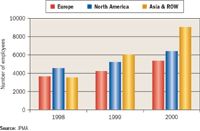
Figure 4. Japanese pharmaceutical companies: overseas employees by region.
Until the introduction of this guideline, lengthy repeated clinical trials were often unavoidable for pharmaceutical companies if they wished to market a drug in more than one ICH region.20 The ICH E5 guideline has been used with some success to streamline clinical development for Western companies wishing to bring their products to Japan, and it is expected that Japanese companies will be able to use the guideline in bringing their products to the United States and Europe.20
Strengthened research abroad
Japanese companies are increasing their presence abroad, and JPMA figures show that a greater percentage of sales are coming from overseas than ever before.
10
In a 1998 survey of its members, less than 12% of sales were coming from abroad, but by 2000 this increased to nearly 21%.
10
However, this overseas presence is not just focused on marketing. During this time, the member companies had also increased the number of research institutes and manufacturing plants they established abroad, and had increased staff numbers at these locations
10
(Figure 4).
Yamanouchi is one Japanese firm that has been transforming itself into a more global company, having established additional operations in North America, Europe, Asia, and South America through the late 1990s. The launch of tamsulosin in the Netherlands under the trade name Omnic was considered highly significant, since this was the first Yamanouchi product to be clinically developed and marketed by the company in Europe.21
Globalization has become key in Fujisawa's company strategy. In 1999, it announced "Vision 2005," a long-term management policy aimed at carrying the company's growth toward 2005 and through to 2010.1, 22 As part of this plan, Fujisawa aims to be a global company, competing with major global companies in targeted therapeutic areas. It aims to have sales of ¥400 billion by 2005 (split 50/50 between Japan and overseas).22 At present it has approximately 350 people working in clinical development in Europe and the United States, where it is carrying out three Phase III trials and 12 Phase II trials.23
One of the reasons for carrying out clinical trial work in the U.S. and Europe has been to give local clinicians the experience of working with Japanese products as they are developed. This will be important if Japanese companies are to be successful in these major medical markets. The focus on Europe and the United States for clinical research has also been driven by a perception that the clinical research environment in Japan is lagging behind.
As with other countries, there have been some medical controversies in Japan that have not helped to promote a good environment for subjects to participate in clinical research.24 Patient understanding of the objectives of clinical research and their trust in those that carry it out remain widely discussed issues. Subject recruitment is already a major issue in running international clinical trials, and thus improving the situation in Japan is in everyone's interest.
Aside from subjects, certain industry figures have openly called for changes in the clinical research environment in Japan. For example, JPMA's President Osamu Nagayama noted at a 2001 news conference that incentives in the U.S. hospital system for clinical research with the industry continued to be better than those in Japan.25 He remarked that at most Japanese hospitals, the system for clinical trials was not organized and that this situation was particularly serious at state-run hospitals.25 He called for formal systems to be established that would allow researchers and their teams to earn incomes from the conduct of clinical trials.25 If Japanese companies believe that they have better chances to run trials in the United States and Europe because of concerns over subject participation and the clinical trial infrastructure in Japan, then the impact of changes currently being made to the Japanese system will be lessened.
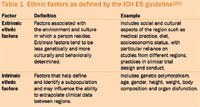
Table 1 Ethnic factors as defined by the ICH E5 guideline(20)
Outlook
There is no doubt that Japanese pharmaceutical companies have a capacity for innovation in new drug development. They are involved in key therapeutic areas and already have a track record of bringing products to the market. However, many are now at a stage where they have openly taken steps to globalize, which will require different research and commercial strategies to rival multinational companies in foreign markets. In particular, the U.S. market is the leading world region for pharmaceutical research and is highly competitive. Most major international companies believe that success here is necessary to drive further growth and thus future research efforts. In Europe, knowledge of the differences between individual countries in terms of clinical practices and regulatory processes, and how these relate to certain European-wide guidelines such as the EU Clinical Trials Directive (2001/20/EC), will be essential for success.
One means by which Japanese companies have sought to operate in these regions is to partner with other local R&D-based organizations to share risk and to benefit from the experience of their partner. Other companies have slowly developed themselves in the United States and Europe over a period of years and have formulated specific strategies for their future operations based on the knowledge they have gained during this time.
Given the pressures that all pharmaceutical companies face, it will be telling to see which Japanese companies have the right strategy to be consistently successful in negotiating the hurdles of clinical development and launching innovative new medicines on an international basis.
References
1.F. Kermani and G. Findlay, "The Pharmaceutical R&D Compendium," (2000); available at http://
www.cmr.org/
2. J. Drews, "Innovation Deficit Revisited: Reflections on the Productivity of Pharmaceutical R&D," Drug Development Technology, 3, 491-494 (1998).
3. M.S. Ogg, M.A. van den Haak, R.G. Halliday, "Activities of the International Pharmaceutical Industry in 2000," CMR International (2001); available at http://www.cmr.org
4. P. Sculthorpe and D. Lowman, "New Medicine Launches 2002," CMR International (2003); http://www.cmr.org
5. F. Kermani and M. Van den Haak, "Drug Development 2001," CMR International (2002); available at http://www.cmr.org
6. "Industry Profile 2002," The Pharmaceutical Research and Manufacturers of America (PhRMA); available http://www.phrma.org
7. G. Ashton and F. Kermani, "Getting to Grips with Attrition Rates," CMR News (2002), 20 (1), 8-9, CMR International; available at http://www.cmr.org
8. D. Jack, "The Japanese Pharmaceutical Industry: Hard Times, Tough Decisions, but a Strong Game Plan," Drug & Market Development, 10, 70-75 (1999).
9. R.G. Halliday, "Japan in Focus: Strategies for Innovation and Global Drug Development-What Differentiates Japanese Pharma Companies from their Western Counterparts?," CMR International (2001); available at http://www.cmr.org
10. Japan Pharmaceutical Manufacturers Association Data Book 1997-1998; available: http://www.jpma.or.jp
11. "Pharmaceutical Outsourcing Trends: An Analysis of the CRO Market Opportunity to 2006," UBS Warburg (November 2001).
12. "IMS Health Reports 11% Growth in Retail Pharmacy Drug Sales for the 12 Months to April 2002" available at http://www.imshealth.com
13. M. Nakamoto and D. Pilling, "Pharmaceuticals 2001/Japanese Focus," Financial Times (April 26, 2001).
14. "Abilify⢠(Aripiprazole) Approved by U.S. Food and Drug Administration for Treatment of Schizophrenia," Bristol-Myers Squibb press release (Nov. 15, 2002).
15. U.-G. Gerdtham, B. Jönsson, M. MacFarlan, H. Oxley, "Factors Affecting Health Spending: A Cross-Country Econometric Analysis, in New Directions in Health Care Policies: Improving Cost Control and Effectiveness," Organization for Economic Cooperation and Development (OECD) Paris, OECD/GD (94) 101 (1995).
16. "Population Aging-A Public Challenge," World Health Organization: http://www .who.int/inf-fs/en/fact135.html
17. "Beyond Borders,"The Global Biotechnology Report 2002, Ernst & Young; available at http://www.ey.com
18. "Japan Biotechnology Industry," Biotech Japan; available http://www.biojapan.org
19. "Ethnic Factors in the Acceptability of Foreign Clinical Data E5," International Conference on Harmonisation of Technical Requirements for Registration of Pharmaceuticals for Human Use (ICH); available at http://www.ich.org/MediaServer.jser?; available at @_ID=481&@_MODE=GLB
20. C. Anderson and F. Kermani, "Global Acceptability of Clinical Data-Fact or Fiction?," European Pharmaceutical Contractor, 8-10 (Autumn 2002).
21. "New Stage in Globalization Marked by Omnic(r) Launch and Opening of Plant in Meppel,"Yamanouchi Newsletter; available at http://www.yamanouchi.com/eg/news/let07.htm
22. "Japanese Drugmakers Take Stock in Difficult Times," Pharma Marketletter, p. 3 (19 April 1999).
23. Fujisawa Annual Report (2003); available at http://www.fujisawa.co.jp/english/
24. "Four Iron Rules to Save You from Hospitals," Shukan Post Watcher, Japan TodayNews, 33 (1)(1 January 2001); available at http://www.japantoday.com/gidx/shukan13.html
25. "Strengthening the Basic Infrastructure of the Pharmaceutical Industry: Issues and Solutions," 7 December 2001 News Conferences held by JPMA President Osamu Nagayama, Japan Pharmaceutical Manufacturers Association; available at http://www.jpma.or.jp
Faiz Kermani, Ph.D., is budgets, proposals and marketing executive for business development with Chiltern International Limited, Wellington House, 20 Queens-mere, Slough SL1 1DB, United Kingdom, +44 (0) 1753 21678, fax +44 (0) 1753 511116, email: faiz.kermani@chiltern.com
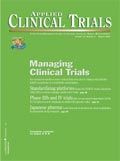
Improving Relationships and Diversifying the Site Selection Process
April 17th 2025In this episode of the Applied Clinical Trials Podcast, Liz Beatty, co-founder and chief strategy officer, Inato, discusses a number of topics around site engagement including community-based sites, the role of technology in improving site/sponsor relationships, how increased operational costs are impacting the industry, and more.
Behind the Buzz: Why Clinical Research Leaders Flock to SCOPE Summit
February 7th 2025In this episode, we meet with Micah Lieberman, Executive Conference Director for SCOPE Summit (Summit for Clinical Ops Executives) at Cambridge Innovation Institute. We will dive deep into the critical role of collaboration within the clinical research ecosystem. How do we bring together diverse stakeholders—sponsors, CROs, clinical trial tech innovators, suppliers, patients, sites, advocacy organizations, investors, and non-profits—to share best practices in trial design, program planning, innovation, and clinical operations? We’ll explore why it’s vital for thought leaders to step beyond their own organizations and learn from others, exchanging ideas that drive advancements in clinical research. Additionally, we’ll discuss the pivotal role of scientific conferences like SCOPE Summit in fostering these essential connections and collaborations, helping shape the future of clinical trials. Join us as we uncover how collective wisdom and cross-industry partnerships are transforming the landscape of clinical research.